ERFAHRUNGEN/ERKENNTNISSE/HINWEISE
ALTE PUBLIKATIONEN/ OLD PUBLICATIONS
"Archaeologische Berichten" Nr.20 (1991): Noch REST-Exemplare sind für 25,- EURO hier erhältlich! Auch andere Exemplare .
Diese Ausgabe hat ihren eigenen Fotobestand und beinhalted die Arbeiten mehrerer Autoren, wie Herrn Jürgen RUST, Schleswig-Holstein Deutschland, Theo Dijkstra, NL, Jeep Ottens, Nl, Vorwort von B. Duppen Holland und Jan Evert Musch, Drenthe, Niederlande.
Themenbereiche aus dem Inhalt: Seiten Nr. 43 und 44, Die Standardisierung.
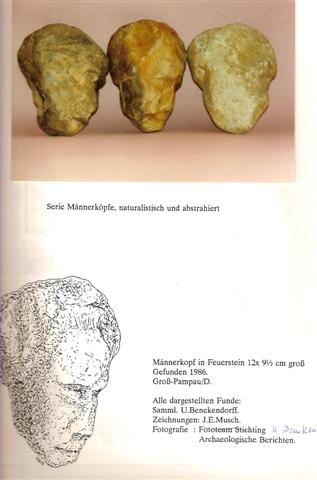 Menschenköpfe in Standardisierung/ size standardisation on human heads in Flint and Granit.
Menschenköpfe in Standardisierung/ size standardisation on human heads in Flint and Granit.
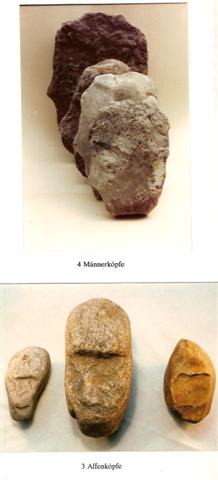 Reduction to characteristic essentials, in all sizes presented in drawings.Ape heads/Affenköpfe in ihrer Reduzierung auf charakteristische Elemente.Rechtes Objekt trägt auf der Rückseite ein Menschengesicht./ Object to the right has a human face on its back side.Both photos taken by Ben DUPPEN, Est. Holland. Also Micro-size apes , which are shown in drawings in smaller size on pages 58 and 59. sind kleine und größere Affenköpfe gezeigt (vgl. Miniaturen Teil I jetzt auf dieser Webseite)
Reduction to characteristic essentials, in all sizes presented in drawings.Ape heads/Affenköpfe in ihrer Reduzierung auf charakteristische Elemente.Rechtes Objekt trägt auf der Rückseite ein Menschengesicht./ Object to the right has a human face on its back side.Both photos taken by Ben DUPPEN, Est. Holland. Also Micro-size apes , which are shown in drawings in smaller size on pages 58 and 59. sind kleine und größere Affenköpfe gezeigt (vgl. Miniaturen Teil I jetzt auf dieser Webseite)
Das Thema der "Affen" ist eine eigenständige Entdeckung von diesem Fundplatz . Es gab hier keinerlei ortsfremde Vorlagen zu den beschriebenen Objekten in dieser Voröffentlichung. Vorausgegangen war bereits eine reichhaltige Auswahl- siehe extra Fotos- von Impressionen zu dem Thema, später wurden so manche Sammlung von paläolithischen Artefakten anderen Ortes, bereichert. Es betrifft alte Sammlungen aus England, Frankreich, Niederlande (Southampton Kongress 1986 England with "Animal Farm" by JEM.) und auch Deutschland ( Prof. Matthes-Sammlung). Frankreichs Sammlungen über die "Boucher de Perthes" Bestände hinaus nach England ( W.Newton) geben keinerlei Hinweise auf die Erfassung und einer Erkennung bzw. Deutung dieser Tierart in paläolithischen Beständen.
Apes and monkeys was a theme of stone remnants from the Old Stone age in Africa,offering in a publication only a weak drawing. See AB Nr. 20. The discovery was my own independant research result. Started here at this find site of Groß-Pampau, Schleswig Holstein, North Germany as early as 1986--follow the pages of the Archaeologische Berichten Nr. 19 and Nr. 20. The "ape- subject" was here deciphered by studying the execution methods applied in former times on stone material, re-appearing over the years of sampling in standardized fashion - see the following photo-series. After publishing the multi mix of materials involved, many collectors followed the idea, adding to their sampled finds this " new theme." No older Collections from England (W. Newton 1913), France ( Boucher de Perthes) Netherlands (1986 Congress Southampton "Animal Farm") and even for Germany (Walther Matthes "Eiszeitkunst im Nordseeraum), offered a similar evidence within their own accumulations of remnants from the past. Perhaps a dating question of this research field?
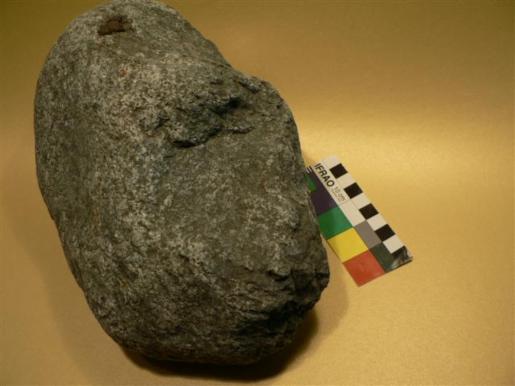
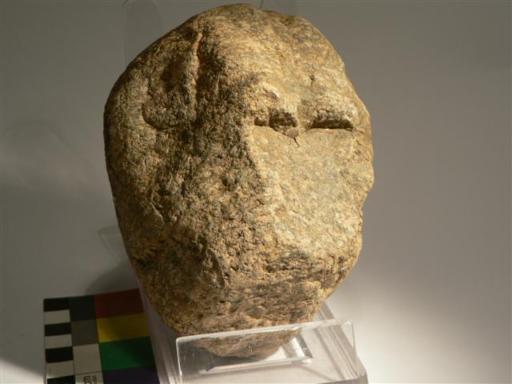
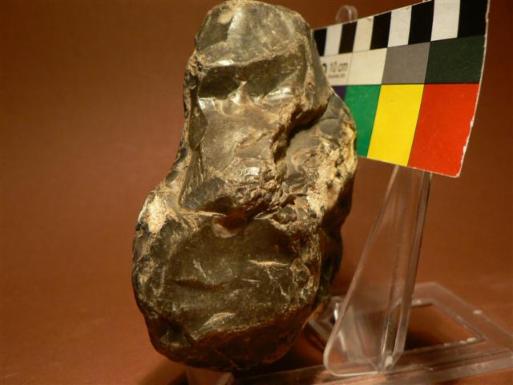
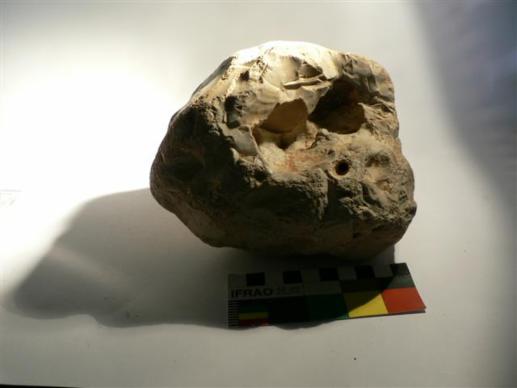
Möglicher Schädel eines Affen mit 2 angedeuteten Nasenöffnungen im Gesichtsfeld. Genaue Bestimmung der Gattung muß weiterer Forschung überlassen sein.
A "cranium" of an ape-head, indicating two "nostrils" at the centre of the face.(precise identity of a species depicted I have to leave to future research).
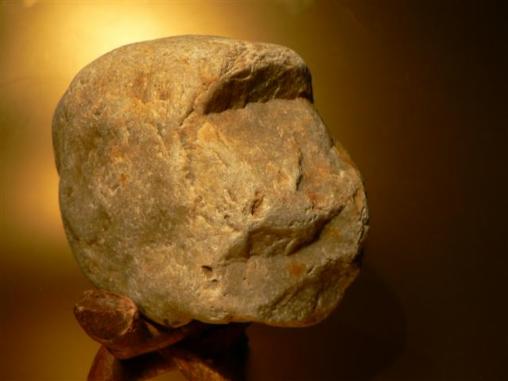
10,8 cm großes quarzit Geröll mit deutlichen Eingriffsmerkmalen wie es auf dem nächsten Stück wiederholt worden ist. Beide Stücke sind fast gleich groß, und überzeugen damit als Artefakt.
10,8 cm in size is this quartzitig pebble with clear working traces that are found repeated on a flint object. Both are of almost identical size and are convincing artefacts.
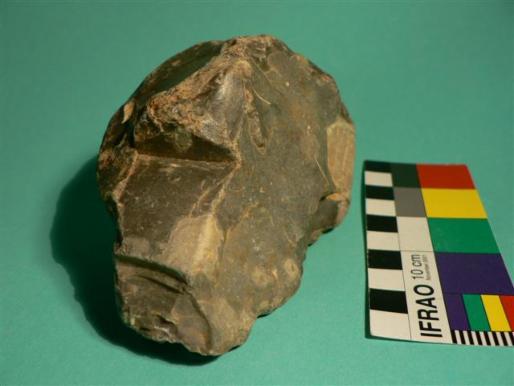
ABSCHLAGSTÜCK IN FLINT/ larger flint fragment below
Ein Feuersteinabschlag mit deutlichen Eingriffsmerkmalen am Stein, zeigt ein Profilgesicht eines Affenköpfchens. Foto unten
Larger flint fragment showing working traces to underline an ape - head in profile.
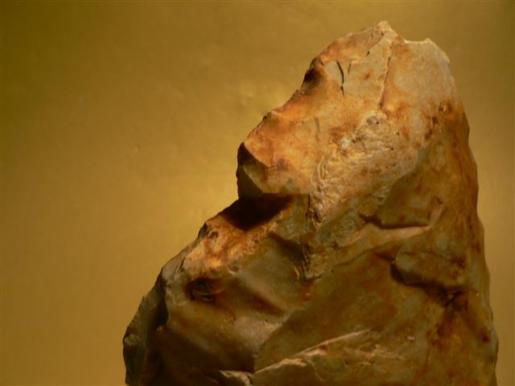
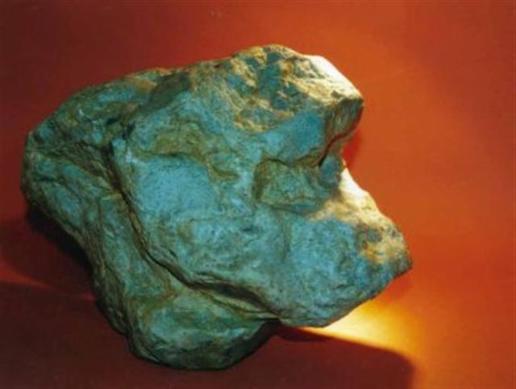
Diese beiden Köpfe - Fotos oben und nachstehend - könnten untereinander als Vorlage gedient haben.
Both impressions of Cranium are possible models.Compare the item above and below.
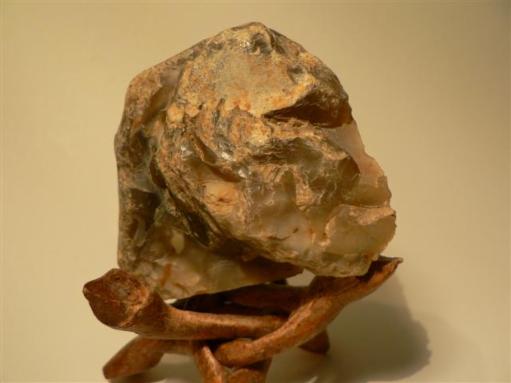
Feuersteinkopf eines Affen im Profil von 9 cm Größe. Nacken- und Halslinie sind klar vom Gesicht getrennt. Zum Vergleich einen Menschenkopf aus Felsgestein, der ähnliche Umrisse trägt und damit einen unmittelbaren Vergleich zuläßt, siehe nächstes Foto.
This ape head in profile of 9 cm size is well shaped to see the neckline clearly separating the face. Compare also to the "human head" in rock below, allowing interpretations.
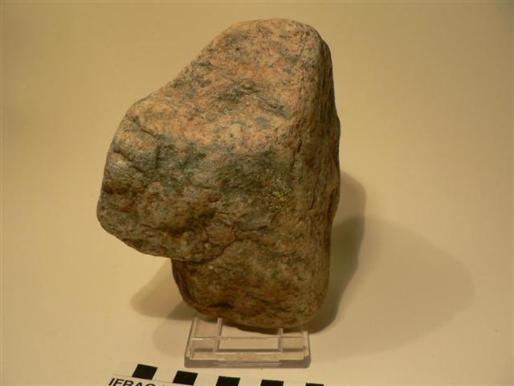
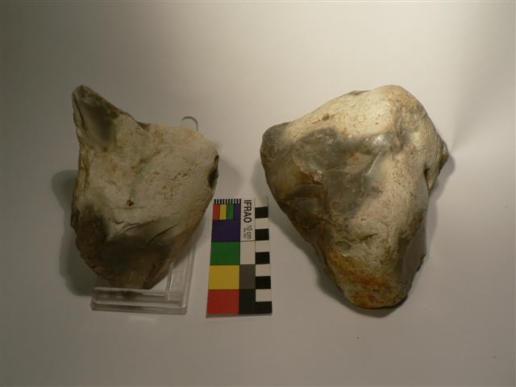
Zwei Objekte mit gleicher Patinierung signalisieren ZUSAMMENHANG. Das Gesicht ist mit einem Auge und schwacher Nasenandeutung den Kopfformen ähnlich, die im Gesamtinventar auch deutliche menschliche Gesichter tragen, also keine vorspringenden Unterkiefer haben, wie das Fundstück zeigt.
2 objects with same patination in white cortex belonging to a large row of similar sampled material indicating several shapes such as fish and other animals. Here the face holds "one eye", weak facial features such as nose and mouth. This face reminds of the human type of head without a larg lower jaw bones, see the next object. The object on the left is perhaps a tool, but not investigated for use-wear - traces.
HAUSAUSTELLUNGSMATERIAL/ OPEN-HOUSE EXHIBITION
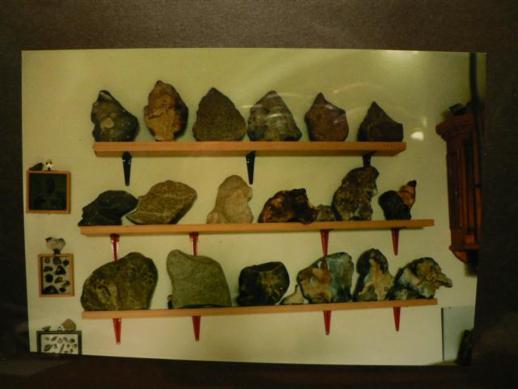
Material displayed at my International Study-Centre, to all visitors from NL, including official Experts from Weimar. Mixture of flint and other rock art, as well as microlithic size. Larger boulder with figuration attached in my garden(see stoneage-art chapter 1, now.
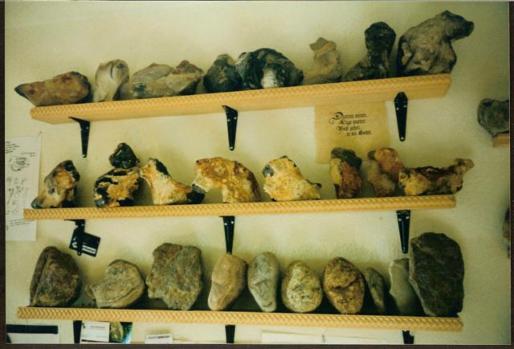
Vorgestellten Material im Hause, unterschiedliche Materialien und Größen sind vorgezeigt. ---------------methodical work brought in short time, 5 years, convincing material from this site. comparing flint to granit and other rock, searching for standardisation, of "manuports" and boulder size research as well.This book shows also artefacts from the internationally accepted "chopping tool" corpus.Deutsche Ubersetzung:
Methodisches Arbeiten erbrachte in nur 5 Jahren überzeugendes Material von dieser einzigen Fundstelle.Es war unter anderem der Vergleich von Materialien, Feuerstein zu Felsgestein, oder Granite, die als tragbare Objekte den Einblick in eine Standardisierung von Skulpturen erbrachte, und dabei wurden auch die größeren Menhire per Foto dokumentiert, hier nicht in dieser Ausgabe gezeigt, jedoch erwähnt.
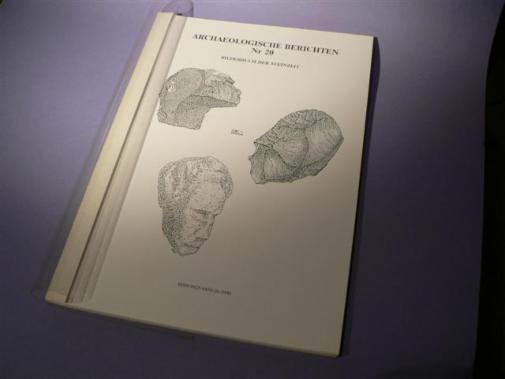
ERSTVERÖFFENTLICHUNG " Vom Informationsträger Stein zum Bilderkatalog der Altsteinzeit" ein Beitrag von U. Benekendorff, Geesthacht, Hamburg mit Fotobeiträgen des Groß-Pampau Fundmaterials durch den niederländischen Vorstand Ben Duppen ELST, Holland.
"A point of contact with an international foundation"
... historical background info. concerning the general theme of suppression of hundreds of stone sculptures, an evidence material of early palaeoart...... SOME WORDS about My experience with this contact and what can be learned from it...
Here a first selected sentence from the foundations statutory laws given in 1983, taken now from the Magazine Nr. 19 with the title "BOUKOUL/COQUELLES" a french site.:
(A noteworthy reflection of "good intentions" but "question marks" accompanied within the best execution intended?)
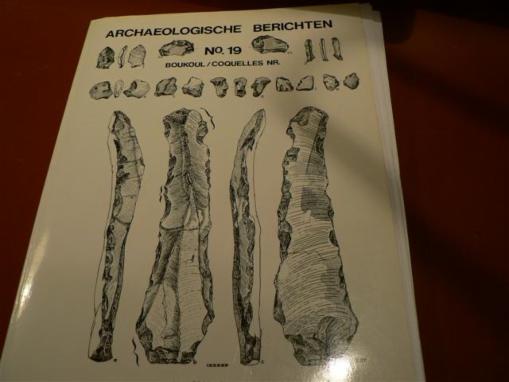
1983........"to compile, to print and to issue this series of monographs, as well as all other activities, that serve to maintain and to continue the character of this series, which is distinguished by the given possibilaties, an as high as possible quality, ORIGINALITY and the DARING to tackle hot issue and to have CRITICAL SENSE." End of citing the first part of interest.
My first contact to the Netherland group was during the 80th of the last century, undertaken in the hope, to see find material from the Netherlands for comparison to my sampled finds, but instead I was offered a number of Magazine issues only, in which I hoped to see such pictures, as found on the cover of the Nr. 15 edition,- see photo below - in which I recognised a Mammuth figuration. But only one and the same picture inside, was all, that got offered, next to "Tools".
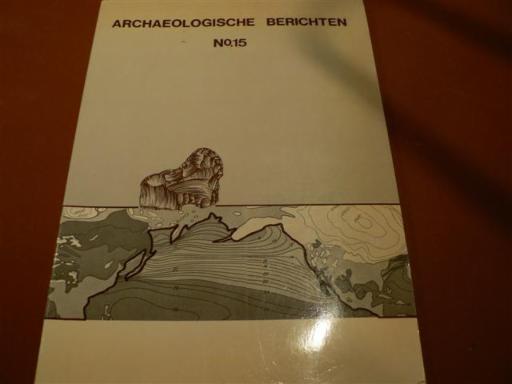
I had, a t that time, purchased the latest numbers of this Magazines series, such was Nr.18,17, 16, and 15, but also numbers 14, 13 etc, not much of relevance to the latest controversional points of discussion, to be followed over my guestbook and Website "guestbooks" of Jan v. Es./INNOxia
A "suppression of stone sculptures within this foundation?"
New find material of the Boukkoulian site of Jan v. Es A site examined for over 20 years under suppression?
His discovery of microlithic material, so everyone can read now openly, was unable to get published, for more than 4 years, a time span, where I was not on the board panel. And to me , hardly understandable in the light of the following sentence, taken from the statutories law, of this foundation in 1983.
...."to offer opportunities to practicing archaeologist and like minds, to make public the results of their studies and their opinion, that would not or insufficiently get this right granted elsewhere." End of citing.
How was such possible? The older Magazines like Nr. 15 and 16, could help here to find ANSWERS ? What kind of "Stichting" is that, practising an "archaeology", that a v o i d s or is not going conform with its principles?
While the edition Nr. 15, is presenting one sculpture next to many tools, the Issue of Nr. 16 , has a word on art, see pages 108-127, also adding drawings of Bear-sculptures, from England, Netherlands, Haddendorf- W Duitsland, and Hejlminde-Denmark.
BUT this "AB Nr. 16" has also an essay by JAN VAN ES, about a find site, consisting of TOOls only called "De Plek", from Helden, NL. here written in co-author-ship with A.Wouters. A second essay begins on page 2, also written by Jan v.Es, here in co-authorship with Dr. Franssen, showing the kind of artefacts similar to the ones discovered at Gr.-Pampau side, presented in drawing later in AB Nr. 20.
It is impossible for an outsider like me to tell, why the Boukoulien Site and its many hundreds or thousands microlithic finds, studied at length by JAN van ES, were not able to find entrance for publication in this Nr. 16 edition consisting of 200 pages, but instead Jan v. Es publishes TOOL finds? Who was suppressing his sculptures in micro tradition? It was the year 1985; a time, where I had just begun serious research switching form my secondary site discoveries to the primary site of Gr.-Pampau. Here I was compiling good and convincing material in only 5 years time and believe to this day, the people of the AB-panel had difficulties accepting micro-tools and micro sculptures? What was their "problem"?
But, when I had confirmed his finds unknowingly through my independant research this "new material" from here can get under no circumstances any priority now, no matter what kind of promises were made ( Written and personal invitations for publication.)
Consequence:.... my discoveries were set back as well by the people in charge of publication administration. I now had to wait, until all Boukoul material was published in AB 19, but having enough material still, to fill up a next edition called AB Nr. 20.
But here in Nr. AB 19, in the year 1989, one finds also the newly discovered ape theme for northern Europe, so as if general knowledge amongst all researchers in NL and of course , all had known suddenly by now about standardisation, however, the only part missing was the" evidence material " for such in AB 19?
GENERAL CONCLUSION: Here an independant discovery like mine, was used to further the themes in sculpture MATERIAL, or palaeoart in NL, so far always believed to occure as an individual component within the artefact category of palaeolithic traditions, therefore not everybodies "Darling" for acceptance in official and amateur research alike. To make the point it is well worth in going back to the NL. AB Nr. 17.
Re-checking this Magazine Nr. 17. Again it was filled with drawings of Tools, consisted of 184 pages, and could have added extra pages with art finds like in AB Nr. 16 reaching a volume of 200 pages , especially seen now in light of the "suppressed" art complex of Boukoulien??? ???? But who am I to say, this was all before my times and my contact with the AB - people, but is a good example, how the argumentation by Jan van Es is grossly twisting facts?
Interesting in connection with parts of my discoveries was for me, however, an essay, printed 1987, in AB Nr. 18, by the researcher RON WILLIAMS from England. This was right after the congress held in Southampton, Engl. 1986. Several researchers from NL got invited by Ron Williams ,a collector and researcher of flint stone only, to come and attend, and why was Jan v. Es not invited there, had he not collected sculptures, no matter what the size -boukoul site- All intern affairs, now the past, and certainly "none of my business" at that time.
A required congress - paper, presented under the title "Animal farm", tells any interested reader, what sort of sculpture themes were known than by "NL research"1986, and is a complete record of the many intern personal discussions amongst the many members, participating in Archeologische Berichten? An ape or Makaake, from Gibraltar, was not under the many drawings in that paper, but was mentioned only later in the essay by Ron Williams ,printed in AB Nr. 18, thus not a scuplture find from NL!
I really do not care that much, but someone ought to have a close look into the matter for the sake of ending this "never ending: ..."You did not invent the apes," argument, which is more than silly.(Apologise)
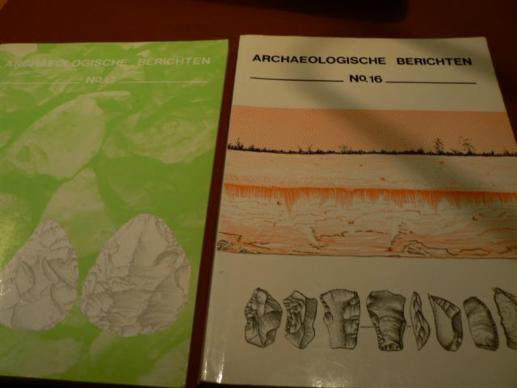
AB 19, tells still about my disappointment about the promised but rejected publication at that time. I was on the verge of leaving the group already at that time, publishing my material in a SELBST-VERLAG, many times practised already by others. Suddenly the offer came, to publish all in AB Nr. 20.
To-day, I consider , for completeness of records, perhaps to print here my letter dated 17.7.1989 sent to the editor at that time, ( will see,) but the reply that followed, gets presented here. (see below). It ended with a sentence "In all solidarity"!!!????(AB19-Oct. 1989) expressed by me in many assisting efforts, and even with relevant pictures still on my webnet about Jan v.Es. finds, until 7th of Jan. 2009. NOW. After all, I consider this a " solidarity", expressed BY ME during 20years, and in last 15years, it seems to me, fading into a very onesided affair.
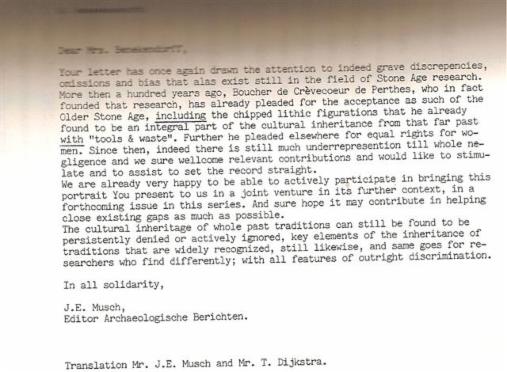
Concluding:
In an effort to make the suppressed material ,like stone sculptures , known to the field of official archaeology, we must listen to their principal arguments, of having difficulties to distinguish between art and non art, or beween non-utilitarian artefacts or ulitiltarian ones. It is suggested by them, we operate with a neutral term "palaeoart" used here in my first paragraph above.
For this see the Nov. 2003 issue of AURA ; VOLUME 20, Nr. 2 by Robert Bednarik, stating:
...."IGNORING THE MATERIAL OR SUPPRESSING IT, IS NOT SO VERY CONDUCTIVE FOR A BETTER UNDERSTANDING?" Rock Art Research 2003
I might add, if solely to us, the amateurs, this large field of research is left to be investigated or to be studied , we at least ought to practise some understanding between us and attend to the many problems involved in a co-operative way, and not act envouisly in hindrance towards other peoples research and efforts, who also try to cope with it all. Such has always been my aim, but of course, it has its limits.?
Jan. 14.th 2009